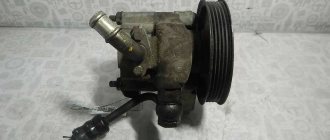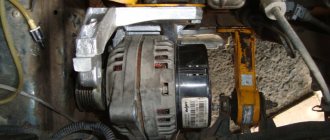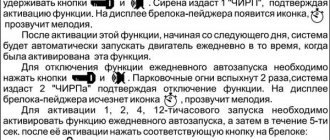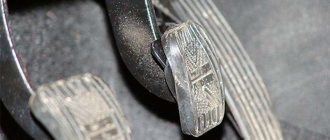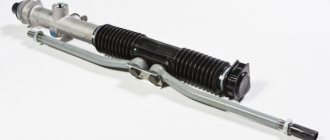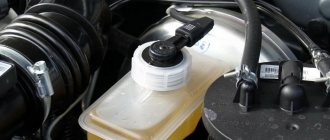Vehicle auxiliary systems are designed to improve not only engine performance, but also for ease of operation, as well as troubleshooting. Auxiliary systems include on-board computers, power steering, electric power steering, etc. Below we will talk about such a device as power steering and its characteristic malfunctions. Recommendations will be given on how to bleed the power steering and what fluids to use in the steering racks.
Lots of details
Power steering is a whole complex of individual units and elements such as:
- Power steering pump
- Steering rack combined with a hydraulic cylinder (there are rack models with an external hydraulic cylinder)
- Working fluid control device (spool mechanism)
- High and low pressure connecting hoses
- Expansion barrel
- Working fluid
The pump is a metal casing, inside of which a drum with blades rotates. As the blades rotate, they capture the working fluid and supply it under pressure to the steering rack. The pump is driven by an engine via a belt drive. In electric boosters, the pump rotates using an electric motor.
The steering rack is made in the form of a cylinder, inside of which there is a gear rack, which is also a hydraulic cylinder rod, a hydraulic cylinder piston and a control mechanism. Steering rods are screwed into the ends of the rack, which are connected to the rotary hub. The steering rod is movably connected to a gear rack through cardan joints.
The spool mechanism is a pressure distributor of the working fluid in the cylinder cavity, depending on the rotation of the steering wheel. It is redirected through channels to the power steering piston, or in the “straight” position, it simply circulates around the ring without doing any work.
The expansion tank is located above the pump level in the engine compartment. It is usually made of durable plastic. Inside it has a filter element and a liquid pressure divider.
Special oils of a certain viscosity and operating temperature are used as the working fluid of the power steering. Usually the manufacturer indicates the specification of power steering oil, but for the average person they also indicate its color, which coincides with the color of the expansion tank cap. For example, the Volkswagen concern uses green. Filling liquids of different specifications is unacceptable; we’ll talk about what this will lead to below.
How it works
Everything is very simple. When the steering wheel is in a straight position, the fluid pumped by the pump is supplied to the distribution mechanism. At this moment, the channels are positioned so that it simply returns to the expansion tank. When the steering wheel is turned, for example, to the right, the distributor channels are aligned so that the fluid begins to flow into the left half of the hydraulic cylinder, helping the driver turn the steering wheel by applying pressure on the rack. As soon as the steering stops turning, the distributor begins to circulate the fluid idle again.
Oops! Accident! Determining the cause of the malfunction
Some typical power steering faults:
The steering wheel is difficult to turn in any direction - most likely, the pump has failed, the wrong specification fluid has been used, or the spool mechanism channels are clogged.
When you turn the steering wheel all the way to one side, you hear a high-pitched whistle. — the drive belt is loose.
The steering wheel turns jerkily. - the fluid does not meet the manufacturer's specifications, the distribution mechanism or pump is faulty.
Increased foaming is observed in the expansion tank. — fluids of different specifications are mixed, the pump is faulty.
When the engine is running, the steering wheel randomly turns in one direction. — the spool mechanism is faulty; the fault most likely lies in contamination of the mechanism channels, or incorrect assembly after installing the repair kit.
List of mechanism breakdowns
Breakdowns are a common occurrence for experienced drivers of such cars. Let us list the main ones that in one way or another will influence the condition of the ZIL-130 power steering:
- drive belt wear or weakening will require replacement of the structural element;
- the appearance of air flows in the system indicates the need to replace the fluid;
- pump failure requires repair or complete replacement of the component;
- An oil level below the required level will require refilling the tank with oil liquid.
We recommend it!
For proper and durable operation of the hydraulic booster, you must adhere to some simple rules:
- Fill only with working fluids recommended by the manufacturer.
- Bleed the system after repair in the following way : connect all the working hoses, fill the expansion tank with the engine off, disconnect the hose after the rack (low pressure), excluding the possibility of the engine starting, crank the engine with the starter until liquid flows through the hole in the rack. Next, clamp the hose fitting and start the engine. Turn the steering wheel several times until it stops in both directions. Observe the entire system for leaks for five minutes. If no leaks are detected, fill to the maximum mark and close the expansion tank.
- Change the drive belt in accordance with the manufacturer's recommendations.
A properly functioning hydraulic booster is the key to safe driving! » alt=»»>
Bleeding the power steering hydraulic system is necessary after any work related to depressurization of the system (replacement of the pump or pipelines).
A sign of air in the system is the steering wheel jamming when you try to turn it sharply.
In addition, the pump makes increased noise when the steering wheel is turned, and the fluid in the reservoir usually foams.
Brake the vehicle with the parking brake and place wheel chocks under the rear wheels.
Raise the front of the vehicle and place it on secure supports so that the front wheels do not touch the ground.
If you have a lift, you can lift the entire car.
Fill the hydraulic booster system with hydraulic fluid to the bottom mark on the dipstick installed in the reservoir plug.
Without starting the engine, turn the steering wheel five to six times left and right until it stops.
Start the engine and turn the steering wheel all the way in one direction. Do not increase engine speed above idle speed.
Criteria for normal functioning
A serviceable power steering on a ZIL-130 meets the requirements for uninterrupted operation:
- return of the steering device to the neutral position under the influence of the pressure difference between sections of the hydraulic system;
- the turning moment of the wheel does not exceed certain dimensions;
- works silently;
- the possibility of a maximum angle of rotation of the wheel when turning the steering wheel;
- extinguished points, impacts transmitted from the wheel to the steering wheel while driving on an uneven surface;
- in the event of a breakdown, full control is maintained;
- the rotation of the wheel is proportional to the rotation of the steering wheel;
- the minimum possible time between turning the steering wheel and triggering the system;
- trouble-free long-term operation.
- ease of maintenance.
Replacing power steering fluid
According to the manufacturer's recommendations, the fluid in the power steering system is not changed throughout the entire life of the vehicle.
However, if the fluid in the reservoir is heavily contaminated or darkened, it should be replaced.
If the fluid is heavily soiled or darkened, check the serviceability of the power steering pump and steering mechanism. They may need to be repaired or replaced.
Raise the front of the vehicle and place it on secure supports so that the front wheels do not touch the ground.
If you have a lift, you can lift the entire car.
Pump out (for example, a syringe or a rubber bulb) the fluid from the power steering reservoir.
Unscrew the nut of the coupling bolt of the tank mounting bracket and remove the bolt from the hole in the bracket
Remove the reservoir from the bracket, loosen the clamp of the fluid return hose and disconnect the hose
Place the end of the disconnected hose into a prepared container.
If the hose is not long enough, extend it with a piece of any hose of suitable diameter.
Drain the power steering system by running the engine two or three times for a few seconds and at the same time turning the steering wheel alternately in both directions until it stops.
Connect the fluid return hose to the power steering reservoir.
Fill the reservoir with fluid and bleed the power steering system
Purpose and design features
Power steering is designed not only to make it easier for the driver to control the car when maneuvering on the road, but also to soften impacts from bumps and damaged road surfaces
It is especially important that the hydraulic booster significantly reduces the likelihood of an accident when a tire breaks, primarily on the front wheels
Power steering is a closed hydraulic system, which includes:
- a tank into which hydraulic fluid is filled;
- pressure regulator;
- control spool;
- pump;
- power cylinder.
The main unit of the hydraulic booster design is the pump. It ensures the pumping of liquid from the tank into pipelines and its further movement under high pressure along the ring. The type of mechanisms used is gate or plate units. They have a sufficient level of efficiency and little wear on the working surfaces. At the same time, they have a weak link; the bearing may fail, which requires repair of the power steering pump.
The operating pressure in pumps of this type, intended for the power steering system, is high, up to a maximum of 150 bar. Such a unit is driven by a belt that simultaneously turns the generator and the pump.
The gaps that are set at the factory during assembly must be maintained in the range of 0.005-0.01 mm. If the gap increases and exceeds the permissible value by 0.01 mm, then a drop in pressure in the system at low speeds is possible; this is felt on the steering wheel as an increase in load, or in the language of professionals - a “tight” steering wheel.
How to pump power steering
Air in the power steering system is dangerous:
- completely changes the operating characteristics of the drive;
- the steering force when rotating is uneven - the driver cannot perform the maneuver accurately;
- The steering wheel is locked in the extreme left or right position, making it impossible to control the car.
How to remove air from the system?
- Raise the car on a lift or hang the front wheels.
- Check if the hoses are torn, make sure that the clamps and pipes are securely tightened.
- Fill the reservoir up to the max mark.
- Start the car for a few seconds to allow the fluid to circulate throughout the system. Add fluid to the maximum and start the car again.
- Fill the tank to the maximum, start the engine. Monitor the oil level and add it as necessary.
- When the oil stops noticeably leaving, turn the steering wheel left and right until it stops several times.
- Turn off the car and repeat the procedure after 5-10 minutes.
Changing power steering oil
If no bubbles form on the surface of the liquid in the tank, there is no air in the system - you can screw on the cap.
How do you know when it's time to bleed your power steering system?
Bleeding the power steering is the first thing to do if the power steering is noisy, foam has appeared in the storage tank, and the steering wheel turns on its own or, conversely, has become stiff.
Causes and consequences of oil foaming in the hydraulic booster
Power steering is one of the additional devices of the car system, which makes driving easier and more comfortable. Like any technical component, the hydraulic booster is capable of breaking, and the problems associated with it are specific and can be very dangerous. In this article we will take a closer look at the reasons why power steering oil foams and how to solve this problem. Most car owners do not pay due attention to this malfunction, and it is in vain, because because of it you may find yourself in mortal danger.
Many motorists can no longer imagine driving a car without power steering.

